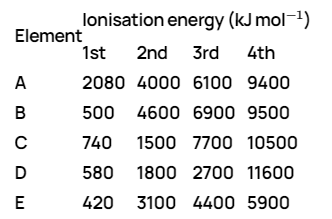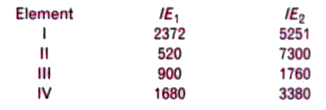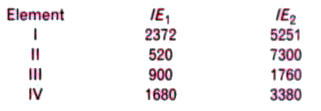The successive ionisation energies in kJ/mol of an element Pare 740, 1500, 7000, 10500, 13600, 18000 and 21700. Which ion is the most likely to be formed when P reacts with chloride?
P2−
P+
P2+
P3+
The correct Answer is:C
After losing two electrons, there is sudden huge increase in IE from 1500 to 7000kJ/mol. It means that after losing two electrons, some stable configuration is achieved. So, element P forms P2+ ion.
Similar Practice Problems
- Question 1 - Select One
The successive ionisation energies inkJmol−1 of an element P are 740, 1500, 10500, 13600, 18000 and 21700. Which ion is the most likely to be formed when P reacts with chloride?
AP2−BP+CP2+DP3+ - Question 1 - Select One
The first three successive ionisation energies of an element Y are 900, 1757 and 14850 kJ mol−1 respectively. The element Y belongs to
Agroup 1Bgroup 2Cgroup 15Dgroup 17 - Question 1 - Select One
The first three successive ionisation energies of an element Z are 1402, 2858 and 4576 kJ mol−1 respectively. The element Z belongs to group
Agroup 1Bgroup 2Cgroup 3Dgroup 15 - Question 1 - Select One
The first three successive ionisation energies of an element X are 520, 7297 and 11810 kJ mol−1 respectively. The element X belongs to
Agroup 1Bgroup 2Cgroup 18Dgroup 15 - Question 1 - Select One
The first three successive ionisation energies of an element M are 800, 2427 and 3638 kJ mol−1 respectively. The element M belongs to group
Agroup 2Bgroup 3Cgroup 18Dgroup 17
Similar Questions
Following table shows the successive molar ionization energy ( kJ mol−1) of five elements A to E.

Which two elements are most likely to be in the same group of the periodic table?View SolutionThe first (IE1) and the second (IE2) ionisation energies (kJ mol−1) of a few elements are given below :

Which of the above elements is likely to be
a reactive metal?View SolutionThe first (IE1) and the second (IE2) ionisation energies (kJ mol−1) of a few elements are given below :

Which of the above elements is likely to be
a noble gas?View SolutionThe first (IE1) and the second (IE2) ionisation energies (kJ mol−1) of a few elements are given below :

Which of the above elements is likely to be
a reactive non-metal?View SolutionSuccessive ionisation potentials of an element 'X'
are IP1=520kJmol−1,IP2=7,298kJmol−1 and
IP3=10,815kJmol−1 Give the probable formulae of chloride and oxide of 'X'.View Solution

